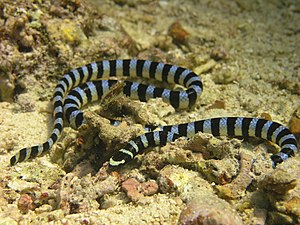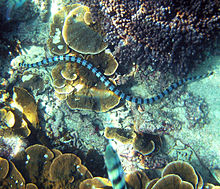Common flattail
| Common flattail | ||||||||||||
|---|---|---|---|---|---|---|---|---|---|---|---|---|

Laticauda laticaudata |
||||||||||||
| Systematics | ||||||||||||
|
||||||||||||
| Scientific name | ||||||||||||
| Laticauda laticaudata | ||||||||||||
| ( Linnaeus , 1758) |
The common flat tail ( Laticauda laticaudata ) is a poisonous snake species from the genus of flat tail ( Laticauda ), which is common on the warm coasts of Southeast Asia and in the western Pacific. The species is classified as not endangered. There are two subspecies.
features

The snakes have a narrow body with an oar-shaped flattened tail. On the top they are blue-gray and ventrally yellowish with brown-black rings along the entire body. The dark rings have a clear border and are the same width or wider than the light rings. They are equally wide dorsally and ventrally. There is a light horseshoe-shaped spot on the head and sometimes one or two light rings on the neck. They have an average total length of 1 meter, with the females being slightly larger than the males. Their scaling shows large ventralia (abdominal scales), each about a third to half the width of the body. The rostral scutum (rostral shield) is undivided and the nasalia (nasal shields) are divided. There are two prefrontalia above it .
The common flattail, like other flattails, is extremely poisonous. The snakes are gentler in nature, but are more likely to bite than the half-banded flattail , so care should be taken when handling them.
| male | female | |
|---|---|---|
| overall length | 91 cm | 107 cm |
| Tail length | 11 cm | |
| Ventralia | 225-243 | |
| Subcaudalia | 38-47 | 30-35 |
way of life
Laticauda laticaudata live in tropical waters near the coast around coral reefs , mangrove forests and harbors with sandy sediment as well as in the open ocean. They are usually found at depths of up to 15 meters, but have also been observed at depths of at least 80 meters. Flattails are often used for molting, ingesting fresh water, and laying eggs on land. However, the species L. laticaudata is more aquatic than, for example, the adder flattail ( L. colubrina ), which is reflected in a significantly narrower body shape. Because of their restricted mobility on land, they are only a few meters away from the water in places where rocks and the like offer protection. When the tide is suitable, the snakes seek out rock caves near the shore to lay their eggs. Since males also congregate in the caves, it is believed that mating takes place on land. Flattails come to the surface to breathe. In species such as Laticauda saintgironsi , diving times of more than 100 minutes have been observed.
The common flattail feeds on eel-like species . The species is diurnal and nocturnal. Australian biologists observed kleptothermia in the Common Flattail , which was cold as a reptile . H. a strategy to benefit from the heat balance of other animals. You could find at a location with a meter animal that in a nesting hole of wedge-tailed - shearwaters ( Puffinus pacificus ) that maintain a constant body temperature of around 37 degrees Celsius, was warming up for three days.
Distribution area and threats
The species is found on coasts in the northeast of the Indian Ocean (East India, Sri Lanka, Myanmar , the Andaman Islands ), around the Malay Archipelago and in the western Pacific (Japan, South Korea, Taiwan, China, Papua New Guinea , Melanesia , Queensland in Australia, Polynesia ) common.
Laticauda laticaudata is classified as Least Concern by the IUCN . In Japan, where the species is most northerly distributed around the Ryūkyū Islands , on the other hand, it is classified as endangered ("Vulnerable") on the national Red List 2020 . Although no quantitative data are available, the number of individuals landing there is declining at many breeding sites. Potential threats are primarily to be seen in connection with global warming . Rising water levels would mean the destruction of suitable habitats in the intertidal zone , which are particularly needed for oviposition. Coral reefs are also an important habitat for snakes, which is increasingly being destroyed by coral bleaching due to rising sea temperatures . In addition, the environment of the breeding grounds has deteriorated due to coastal development. The common flattail is also traditionally caught for food in Japan.
Systematics
Laticauda laticaudata is the nominate form of the genus flattails ( Laticauda ), which belongs to the poisonous snake family. The genus and species name is made up of the Latin words “latus” (broad) and “cauda” (tail), similar to the German common name “flat tail”. The species was first described in 1758 by the Swedish naturalist Carl von Linné (Latinized Carolus Linnaeus) as Coluber laticaudatus . The species was classified in the genus Laticauda in 1907 by the American zoologist Leonhard Stejneger .
Synonyms
Synonyms to be found in the literature are sorted by time
- Coluber laticaudatus Linnaeus , 1758
- Laticauda scutata Laurenti , 1768
- Platurus laurenti Rafinesque , 1817
- Coluber platycaudatus Oken , 1836
- Platurus laticaudatus Girard , 1858
- Platurus fischeri Jan , 1859
- Platurus fischeri Anderson , 1871
- Platurus muelleri Boulenger , 1896
Subspecies
A distinction is made between two subspecies (as of July 2021):
- Laticauda laticaudata affinis ( Anderson , 1871)
- Laticauda laticaudata laticaudata ( Linnaeus , 1758)
Related species
| L. colubrina | L. semifasciata |
 |

|
The closest related species, Laticauda crockeri, is common in brackish lakes in the Solomon Islands . The related species also include the adder flattail ( L. colubrina ) and the half-banded flattail ( L. semifasciata ), each of which has a similar distribution area. The adder flattail is outwardly similar to the common flattail. However, it differs in that the black rings in the striped pattern are significantly narrower than the light ones. In addition, the shape of the body and tail is less flattened. The half-banded flattail has a blue-gray to gray-brown basic color and a significantly paler stripe pattern.
Web links
- Laticauda laticaudata In: The Reptile Database ; accessed on July 19, 2021.
- Laticauda laticaudata in the endangered Red List species the IUCN 2021. Posted by: Lane, A., Guinea, M. Lobo, A. & gatus, J., 2009. Accessed July 19, 2021st
- Observations of Laticauda laticaudata. iNaturalist, accessed July 20, 2021 .
Individual evidence
- ↑ a b c d e f g 改 訂 ・ 沖 縄 県 の 絶滅 の お そ れ の あ る 野生 生物 (レ ッ ド デ ー タ お き な わ) 第 3 版 動物 編 3.5 爬虫 類 (Red List Okinawa - Reptiles: Description of the species). (PDF, 851 KB) Okinawa Prefecture , accessed July 21, 2021 (Japanese).
- ↑ a b c Stejneger, Leonhard H. 1907. Herpetology of Japan and adjacent territory. Bull. US Natl. Mus. 58: 402-406 Biodiversity Heritage Library
- ↑ a b Leviton, Alan E .; Guinevere OU Wogan; Michelle S. Koo; George R. Zug; Rhonda S. Lucas and Jens V. Vindum 2003. The Dangerously Venomous Snakes of Myanmar Illustrated Checklist with Keys. Proc. Cal. Acad. Sci. 54 (24): 407-462 PDF 2.3 MB
- ↑ Weinell, Jeffrey L .; Errol Hooper, Alan E. Leviton, Rafe M. Brown 2019. Illustrated Key to the Snakes of the Philippines. Proc. Cal. Acad. Sci. (4) 66 (1): 1-49 PDF
- ↑ a b c d e Laticauda laticaudata In: The Reptile Database ; accessed on July 19, 2021.
- ↑ a b c Laticauda laticaudata in the endangered Red List species the IUCN 2021. Posted by: Lane, A., Guinea, M. Lobo, A. & gatus, J., 2009. Accessed July 19, 2021st
- ^ Cogger, H. 2007. Marine Snakes. In: T. Vickey and S. Keable (eds), Description of Key Species Groups in the East Marine Region, pp. 80-94. Australian Museum.
- ↑ Brischoux, F., Bonnet, X. and Pinaud, D. 2009. Fine scale site fidelity in sea kraits: implications for conservation. Biodiversity and Conservation 18 (9): 2473-2481.
- ↑ Guinea, ML 1994. Sea Snakes of Fiji and Niue. In: P. Gopalakrishnakone (ed.), Sea Snakes Toxinology, pp. 212. NUS Press, Singapore.
- ↑ Shine, R., Reed, R., Shetty, S., Lemster, M. and Mason, RT 2002. Reproductive isolating mechanisms between two sympatric sibling species of sea snakes. Evolution 56 (8): 1655-1662.
- ↑ Bacolod, PT 1983. Reproductive biology of two sea snakes of the genus Laticauda from the central Philippines. The Philippine Scientist 21: 155-163.
- ↑ Snakes at sea: diving performance of free-ranging sea kraits. (PDF; 447 KB) François Brischoux, Xavier Bonnet, Timothée Cook, Richard Shine, pp. 9-10 , accessed on August 7, 2021 (English).
- ^ Heatwole, H. 1999. Sea Snakes. Krieger Publishing Company, Malabar, Florida.
- ↑ Ineich, Iva N, Andpierre. Laboute. 2002. Sea Snakes of New Caledonia. Institute de Recherché pour le Development. Muséum National d'Histoire Naturelle, Paris. 301 pp.
- ↑ Brischoux François, Xavier Bonnet and Shine Richard, 2009. Kleptothermy: an additional category of thermoregulation, and a possible Example in sea kraits (Laticauda laticaudata, Serpentes) , Biol. Lett. 5729-731 abstract
- ↑ 環境 省 レ ッ ド リ ス ト 2020 (Red List 2020). (PDF, 662 KB) Japanese Ministry of the Environment, p. 9 , accessed July 21, 2021 (Japanese).

